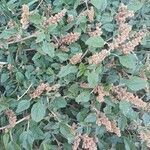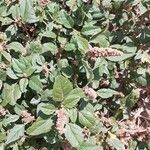Plants short-lived perennial or annual, pubescent in distal parts of plant or becoming glabrescent at maturity. Stems ascending or prostrate, profusely branched basally, radiating from rootstock, mostly 0.2-0.5 m. Leaves: petiole 1/2 as long as to equaling blade; blade rhombic-ovate or ovate to lanceolate, 1-2 × 0.5-1 cm, base tapering or cuneate, margins entire, plane or slightly undulate, apex subacute, obtuse, or retuse or shallowly emarginate, mucronulate. Inflorescences terminal, erect, compact, pyramidal panicles and also some axillary clusters, green or silvery green, occasionally tinged with red, leafless at least distally. Bracts of pistillate flowers linear, 0.5-1 mm, 1/2 as long as tepals. Pistillate flowers: tepals 2-3, narrowly elliptic or oblanceolate, not clawed, equal or subequal, 1.2-2 mm, apex broadly acute; style branches erect; stigmas 3. Staminate flowers clustered at tips of inflorescences; tepals 2-3; stamens 2-3. Utricles marked with 2(-3) green lines that intersect at apex and divide fruit into halves or quarters, slightly to distinctly inflated, ellipsoid, 2-3 mm, distinctly longer than tepals, smooth (in dry plants wrinkled or rugose), indehiscent. Seeds very dark brown to black, 1-1.2 mm diam., shiny, filling only proximal portion of fruit.
Annual or short-lived perennial with green or brownish procumbent or decumbent branched stems often forming large mats. Petioles to c. 2.5 cm long, ± puberulent. Lamina 0.5-4-(6) × 0.3-2.25-(3) cm, sometimes larger on vegetative shoots, ovate, triangular-ovate, to rhombic, glabrous above except for midrib, sometimes puberulent on veins below, sometimes glabrate; base cuneate; apex obtuse to acute. Infl. a terminal spike, often interrupted; lateral branches below with short lateral spikes in upper lf-axils. Bracteoles 1-1.5-(2) mm long, ovate, keeled, green, glabrous. Tepals 2-3, scarcely > bracteoles, oblong, linear-oblong, or oblong-spathulate, keeled, mucronate. Fr. ellipsoid, compressed, smooth, indehiscent, with 3 longitudinal lines, 1.5-2× perianth when mature. Seed 0.8-1-(1.1) mm diam., broadly obovoid, dark brown, only occupying part of lower 1/2 of capsule.
Monoecious; prostrate or ascending, 2–5 dm; lvs lanceolate to broadly ovate, 1–3 cm; petiole about equaling the blade; terminal panicle dense, narrowly ovoid, 2–5 cm; smaller clusters also present in the upper axils; bracts shorter than the fr; sep of the pistillate fls 2, oblanceolate, two-thirds as long as the fr, acute; fr smooth, flat-ellipsoid, 2.5 mm, half as wide, indehiscent; seed obovate, shining, 1.2 mm; 2n=34. Probably native to tropical Amer., occasionally found in waste places in our range, especially along the coast.
Perennial herb, stems annual, prostrate or ascending, glabrous. Leaves green beneath, lamina ovate to lanceolate or almost elliptic, glabrous or nearly so above, pubescent on margins, midrib and lateral nerves; axils without spines; petioles 5-30 mm long. Inflorescences in terminal spikes, shorter spikes or clusters often present, with male or female flowers. Flowering time Oct.-Feb. Seeds very glossy, ellipsoid compressed, blackish brown, 1.0-1.2 mm long, smooth.
Leaves moderately to more or less densely furnished on the margins and inferior surface (especially of the principal veins) with similar multicellular hairs, long-petiolate (petioles 6–25 mm. long, but rarely, if ever, exceeding the lamina), lamina c. 1–4.5 × 0.5–2.5 cm, broadly ovate to lanceolate (most commonly rhomboid-ovate), subtruncate to shortly cuneate at the base, subacute to obtuse and sometimes shallowly retuse at the mucronulate apex.
Perennial herb, up to 0.4 m high. Stems procumbent to ascending, many from rootstock. Leaves with blade ovate to elliptic, 10-45 x 5-25 mm. Flowers: inflorescence a terminal branched or spike-like panicle; female perianth with 2 or 3, linear to oblong, narrowly obovate segments, acute or shortly acuminate at apex, green; Oct.-Feb. Fruit clearly exceeding perianth, indehiscent, smooth, rounded or obtuse at apex.
A herb that keeps growing from year to year. It only lives for a few years. It lies along the ground and can curve upwards. It can be 12-45 cm long. It usually branches at the base. The leaves usually have hairs along the edges and underneath. The leaves are 1-5 cm long by 1-3 cm wide. They are broadly oval. The flower spikes are reddish-green.
Flowers green, in slender and lax to stout and dense terminal and axillary spikes c. 2–10 cm long and 5–12 (20) mm. wide, the terminal spike not rarely with rather short, stout branches and the lowest inflorescences dense, subglobose clusters to c. 1 cm in diam.; male and female flowers intermixed, the males generally rather few.
Stems several, slender to rather stout, usually much-branched from the base upwards, more or less angular, green to reddish, glabrous below but usually increasingly furnished from well below the middle upwards with yellowish, flexuose or crisped multicellular hairs.
Numerous, annual, herbaceous stems from rootstock up to 400 mm tall. Inflorescence a terminal branched or spike-like panicle. Fruit clearly exceeding perianth, indehiscent, smooth, 1.75-3.00 mm long, rounded or obtuse at apex. Flowers green.
Perianth segments 2–3, 1.5–2 mm., linear-to oblong-spathulate, obtuse to subacute, male and female similar or the male shorter and somewhat more acute, pale-membranous with the thin to thick green midrib excurrent in a short, paler mucro.
Capsule ellipsoid, sometimes constricted above, 1.75 v 3 mm., obviously exceeding the perianth, scarcely compressed, smooth, indehiscent or irregularly rupturing at maturity.
Bracts and bracteoles deltoid-ovate to ovate-lanceolate, pale-membranous with a shortly excurrent greenish midrib, bracteoles usually about half the length of the perianth.
Seeds compressed-ellipsoid, c. 1–1.2 × 0.7–0.8 mm. in diam., black, shining and almost smooth, with a duller, slightly rugose border.
Perennial herb, prostrate to somewhat ascending, (8) 12–45 (80) cm.
Stigmas 2–3, pale, slender, flexuose, c. 0.4 mm. long.












